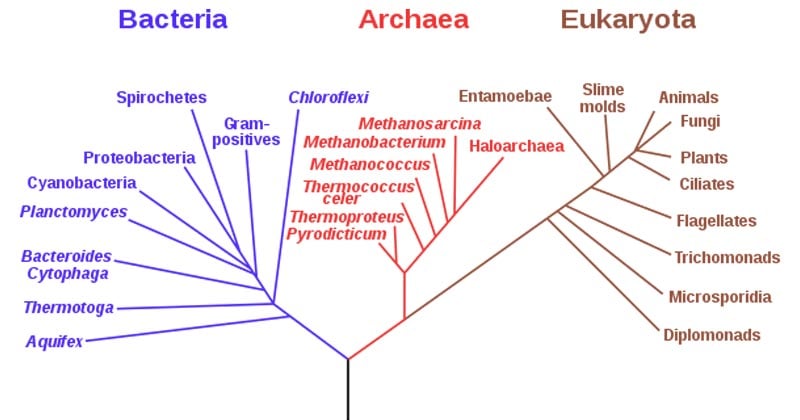The three-domain system was first introduced by Carl Woese in 1990 that is why its called Carl Woese’s Classification. This classification system also is known as the Six Kingdoms and Three Domains Classification because it divides the life forms into three domains and six kingdoms.
The three-domains of Carl Woese’s Classification system include archaea, bacteria, eukaryote, and six kingdoms are Archaebacteria (ancient bacteria), Eubacteria (true bacteria), Protista, Fungi, Plantae, Animalia.
This classification system divides the life based on the differences in the 16S ribosomal RNA (rRNA) structure and as well as the cell’s membrane lipid structure and its sensitivity to antibiotics. The main difference from earlier classification systems is the splitting of archaea from bacteria.
The evaluating rRNA structure is very helpful. As a result of rRNA molecules, throughout nature perform the identical function, their structure modifications very little over time. Subsequently, similarities and dissimilarities in rRNA nucleotide sequences are a very good indication of how associated or unrelated completely different cells and organisms are.
In this classification, Carl Woese uses 16S ribosomal RNA (rRNA) as a ‘Chronometer’, because of;
- It is universally distributed means its presence in all species.
- It is functionally similar in all organisms.
- It can change its sequence slowly.
- Its sequences can be aligned, or matched up, between 2 organisms.

Image Source: Eric Gaba.
Interesting Science Videos
Domains of Carl Woese’s Classification
Carl Woese’s Classification is made of three domains such as
- Domain Archaea
- Domain Bacteria
- Domain Eukarya
1. Domain Archaea
The Archaea domain includes all prokaryotic cells, they lack nuclear membrane; have distinct biochemistry; contain RNA markers from bacterial cells. The Archaea are considered as the oldest species of organisms on Earth. They can survive in extreme, harsh environments that differentiated them from other domains. The cell wall of archaea lacks peptidoglycan. Archae also contains ether leakage in their membranes.
Archae has three phyla such as;
- Crenarchaeota: They can survive at extremely high temperatures and extremely low temperatures.
- Euryarchaeota: Some of them are known as extremely halophiles, which can prevent inhibit highly saline environments.
- Konarchaeota: It includes all those species were found in a single hot spring, Obsidian Pool, present in Yellowstone National Park (USA).
2. Domain Bacteria
These are also prokaryotic cells with bacterial rRNA and contain diacyl glycerol diester lipids in their membrane. They are also called eubacteria or “true bacteria”. Their cell membrane contains ester linkage between unbranched fatty acid chains and glycerol. Their cell wall made up of peptidoglycan.
There are present 5 phyla of the bacterial domain such as;
- Proteobacteria: The example of proteobacteria is E. coli, Salmonella typhus, Legionella, Heliobacter pylori (cause of many ulcers), Neisseria gonorrhea (cause of gonorrhea).
- Cyanobacteria: The example of Cyanobacteria is Photosynthetic ‘blue-green’ bacteria which produces O2 gas.
- Eubacteria: The example of Eubacteria is Clostridium (tetanus, botulism), Bacillus, Mycoplasma (walking pneumonia).
- Chlamydias: The example of Chlamydias is Giardia, Chlamydia (STD), etc.
- Spirochaetes: The example of Spirochaetes is Spiral bacteria that cause syphilis, Lyme disease.
3. Domain Eukarya
These are eukaryotic cells with a membrane-bound nucleus. Their membranes contain their membranes between unbranched fatty acid chains and glycerol. They lack peptidoglycans on their cell wall. Eukarya inhibit the antibacterial antibiotics but sensitive to antibiotics that affect eukaryotic cells.
There are presently four Kingdoms of Eukarya such as;
- Protista: These are slime molds, euglenoids, algae, and protozoans.
- Fungi: These are sac fungi, club fungi, yeasts, and molds.
- Plantae: These are mosses, ferns, conifers, and flowering plants.
- Animalia: These are sponges, worms, insects, and vertebrates.
References and Sources
- 8% – http://faculty.ccbcmd.edu/courses/bio141/lecguide/unit1/3domain/3domain.html
- 3% – https://paleontology.fandom.com/wiki/Three-domain_system
- 2% – https://wikimili.com/en/Three-domain_system
- 2% – https://wikimili.com/en/Kingdom_(biology)
- 2% – http://www.biology.iupui.edu/biocourses/N100/2k43domainnotes.html
- 1% – https://www.researchgate.net/publication/281511514_Nanoarchaeota_Their_Sulfolobales_Host_and_Nanoarchaeota_Virus_Distribution_across_Yellowstone_National_Park_Hot_Springs
- 1% – https://www.ncbi.nlm.nih.gov/pmc/articles/PMC3720003/
- 1% – https://sciencing.com/list-singlecell-organisms-8543654.html
- 1% – https://quizlet.com/222479198/microbiology-ch-1-the-main-themes-of-microbiology-flash-cards/
- 1% – https://quizlet.com/102833324/prokaryotes-flash-cards/
- 1% – https://idoc.pub/documents/how-is-life-classified-qn858pq59kn1

Hi my name is penumaka harshini. I am very intrested to read this classification that which I can understand easily …because of easy sentence formation.. thanku soo much..